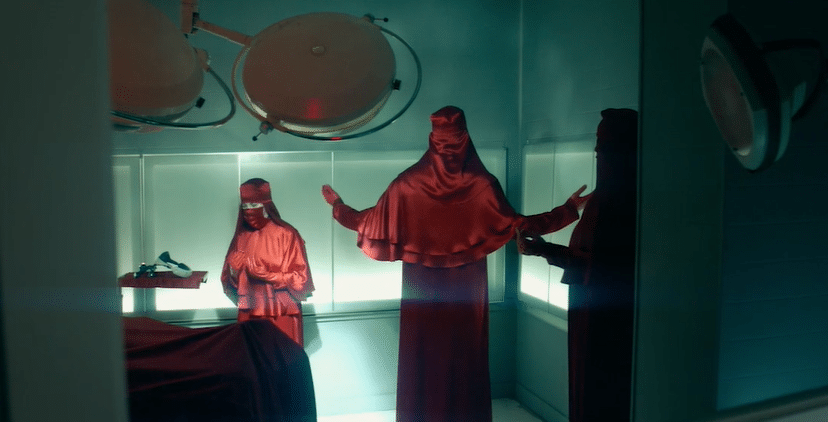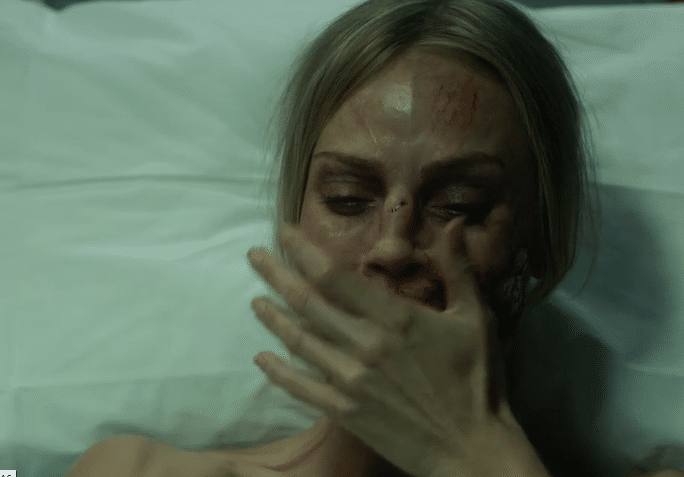When I first heard that the Soska twins were directing a remake of David Cronenberg’s 1977 movie Rabid, I think, like many people, I wondered what on earth they were going to do with it. Whilst not an obvious choice for a glossy re-imagining, it’s also a film with plenty of potential for a new perspective: given Jen and Sylvia Soska’s rather variable output since their first real calling card American Mary in 2011, however, it was a project which could go either way. Happily, the finished article has lots going for it, forging something which strikes a balance between source material and new ideas. This is a pretty savage body horror of its own sort, brought up to date in a series of ways which don’t feel like mere lip service to modern concerns.

The House of Gunter is a prestigious fashion house with the prerequisite cruel, eccentric owner who gives the company its name; one of his employees, Rose Miller (Laura Vandervoort) might be a talented designer and seamstress, but she is making none too positive an impression. Mousy, uncertain, frequently late, her position is by no means assured, especially at such an important time: Gunter is about to launch his newest range, ‘Schadenfreude’, a range which will in his own words showcase ‘the dark night of the soul’. Rose’s dark night of the soul starts here: when she is invited to a party by the good looking journalist Brad (Benjamin Hollingsworth), she’s flattered, and her friend and colleague Chelsea helps her pick out an outfit. However, at the party Rose overhears that Chelsea put Brad up to it: humiliated, she leaves, gets on her moped and immediately lands herself in a serious traffic collision – not her first accident, given that she already had facial scarring, but this time things are far more significant. Rose is unconscious for a week. When she wakes up, she begs to see what has happened to her face. With a horribly disfigured face and a wired jaw, she can’t even speak to say how she feels.
Despite her earlier meddling, Chelsea wants to show herself to be a good friend, and she offers for Rose to stay with her whilst she recuperates. Rose agrees, glad of the support. Scrolling through her emails one day, she notices one from a clinic offering radical, experimental surgery from a ‘transhumanist’ perspective – but never mind the philosophy, they’re offering free care based on cutting-edge stem cell research in return for some ‘minimal blood work’. Medical care costs a lot of money in America. This is almost motivation enough. Rose and Chelsea go along to see what’s what, and despite her misgivings, Rose decides to undergo their suggested procedure. It works brilliantly, but as with all such successes, there’s a terrific, chaotic price for Rose and those around her.

There are many good qualities to admire here: this is a stylish film, well shot and lit with a great eye for colour. If Cronenberg’s Rabid was somewhat dour and grim, then this is the opposite; the use of practical SFX is very welcome, too, with some particularly unpleasant, and therefore skilled depictions of injury and surgery. During their career to date, the Soskas have done a very good job at turning the operating theatre into…well, theatre, and Rabid is no slouch in that respect. Also, on a personal note, as someone who’s had a doubly-broken jaw and reconstructive surgery, some of the footage of a very hungry Rose trying desperately to eat or drink something gave me some mild flashbacks. Ain’t no hunger like the kind where you can’t physically open your mouth (except maybe, the kind which comes later in the film). Speaking of Rose, she is far more of a rounded character for me than ‘American’ Mary, and the film does successfully generate pathos for her situation. In her chosen industry, the forces which drive the emphasis on looks are perhaps even more brutal than elsewhere, and watching people’s sudden warmth towards her when she ‘looks the part’ is well-handled. The film hinges on vanity – its artifice, but also its genuine importance to people.

In other respects, Rabid invokes some very modern demons: it tackles ‘clean eating’ and conscientious consumption, the ubiquity of plastic surgery and – without feeling like you’re being beaten around the head with an agenda – the phenomenon of street harassment of women by men. For all that, key elements of the original are retained, with some nice nods to Cronenberg (look out for them) and that self-same sense of things rapidly spiralling out of control. Whilst some of the new-direction stuff of the end scenes sat a little oddly, and whilst I still can’t be persuaded that the director cameos contribute anything, this is an entertaining horror film.
In effect, Rabid feels like the film which the Soskas shoulda-woulda-coulda made right after American Mary. There are recognisable parallels between that earlier film and Rabid, but with Rabid there is evidence of lessons learned – a defter touch, and a sense of progression which I don’t feel that you get from their other interim projects. It’s pleasing to see, and I really hope that these directors can use Rabid to generate momentum for their next pitch, as it would be a crying shame were this not the case.
Rabid gets a UK release via 101 Films on 7th October 2019.
